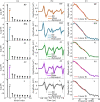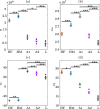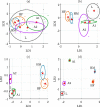Dynamic modeling of photoacoustic sensor data to classify human blood samples
- PMID: 37880558
- PMCID: PMC10794472
- DOI: 10.1007/s11517-023-02939-3
Dynamic modeling of photoacoustic sensor data to classify human blood samples
Abstract
The photoacoustic effect is an attractive tool for diagnosis in several biomedical applications. Analyzing photoacoustic signals, however, is challenging to provide qualitative results in an automated way. In this work, we introduce a dynamic modeling scheme of photoacoustic sensor data to classify blood samples according to their physiological status. Thirty-five whole human blood samples were studied with a state-space model estimated by a subspace method. Furthermore, the samples are classified using the model parameters and the linear discriminant analysis algorithm. The classification performance is compared with time- and frequency-domain features and an autoregressive-moving-average model. As a result, the proposed analysis can predict five blood classes: healthy women and men, microcytic and macrocytic anemia, and leukemia. Our findings indicate that the proposed method outperforms conventional signal processing techniques to analyze photoacoustic data for medical diagnosis. Hence, the method is a promising tool in point-of-care devices to detect hematological diseases in clinical scenarios.
Keywords: Data-driven models; Dimensionality reduction; Photoacoustics; Signal processing.
© 2023. The Author(s).
Conflict of interest statement
The authors declare no competing interests.
Figures






Similar articles
-
Photoacoustic and absorption spectroscopy imaging analysis of human blood.PLoS One. 2023 Aug 4;18(8):e0289704. doi: 10.1371/journal.pone.0289704. eCollection 2023. PLoS One. 2023. PMID: 37540721 Free PMC article.
-
Image reconstruction with the Heaviside equation in photoacoustic tomography accounting for dispersive acoustic media.J Biomed Opt. 2018 Jul;23(7):1-12. doi: 10.1117/1.JBO.23.7.076010. J Biomed Opt. 2018. PMID: 30027712
-
Strategy for Fluorescence/Photoacoustic Signal Maximization Using Dual-Wavelength-Independent Excitation.Anal Chem. 2023 Dec 12;95(49):18029-18038. doi: 10.1021/acs.analchem.3c02372. Epub 2023 Nov 29. Anal Chem. 2023. PMID: 38019809
-
Photoacoustic breast tomography prototypes with reported human applications.Eur Radiol. 2015 Aug;25(8):2205-13. doi: 10.1007/s00330-015-3647-x. Epub 2015 Feb 27. Eur Radiol. 2015. PMID: 25721319 Review.
-
Towards Clinical Translation of LED-Based Photoacoustic Imaging: A Review.Sensors (Basel). 2020 Apr 27;20(9):2484. doi: 10.3390/s20092484. Sensors (Basel). 2020. PMID: 32349414 Free PMC article. Review.
Cited by
-
Study of erythrocyte sedimentation in human blood through the photoacoustic signals analysis.Photoacoustics. 2024 Mar 2;37:100599. doi: 10.1016/j.pacs.2024.100599. eCollection 2024 Jun. Photoacoustics. 2024. PMID: 38495950 Free PMC article.
References
MeSH terms
Grants and funding
LinkOut - more resources
Full Text Sources
Research Materials

